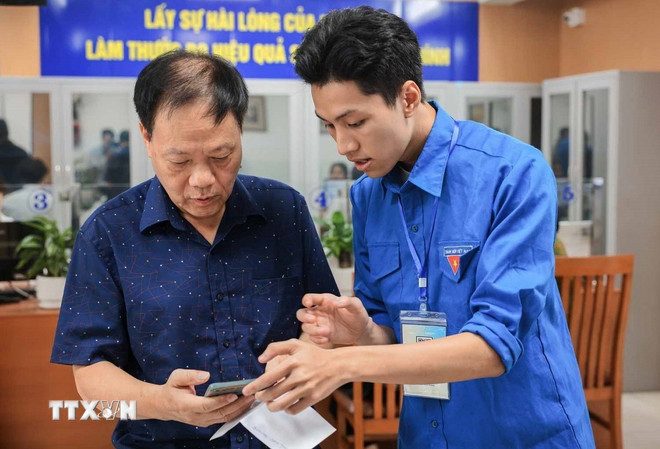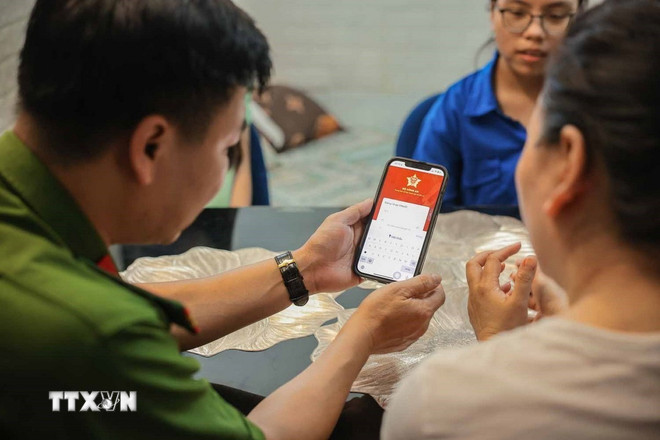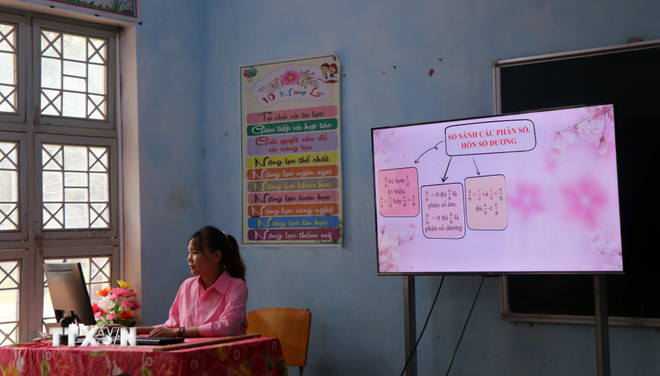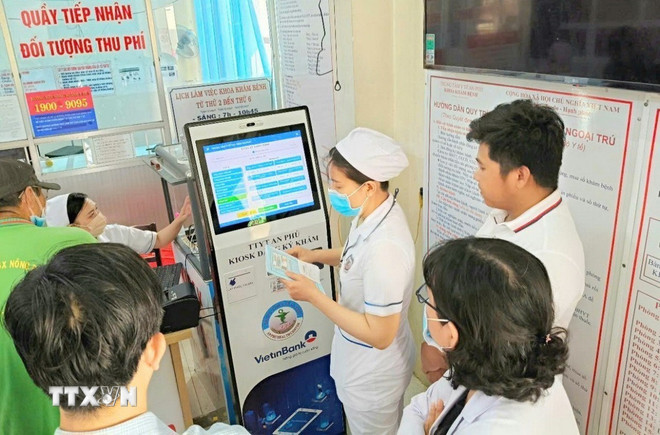Digital transformation has been identified by our Party and State as one of three strategic breakthroughs in the new era, as set out in Resolution No. 57-NQ/TW of the Politburo on breakthroughs in science and technology development, innovation and national digital transformation.
Making digital transformation the foundation of national development in the new era is not only an urgent requirement but also a strategic choice for Vietnam to make a breakthrough, shorten the gap, integrate deeply and enhance competitiveness.
This is a cross-cutting task, requiring the synchronous participation of the entire political system, business community and society as a whole, to create a modern and effective digital economy , digital society and digital government.
"Right-hand man" in operating two-level government
In Cua Nam ward ( Hanoi city), many new steps in digital transformation have been implemented after operating two-level local government.
Ms. Trinh Ngoc Tram, Vice Chairman of the People's Committee of Cua Nam Ward, said that before the official operation of the two-level government on July 1, the ward had 10 days of testing with a simulated public administration office, posing many real-life situations for staff to handle.
This process helps to detect difficulties early, synthesize and resolve them promptly, so that when officially put into operation, there are not many initial problems.

In addition to equipping digital skills for officials, the ward has consulted experts, asked for opinions from leaders at all levels and boldly introduced AI robots into public administration services, aiming to build a friendly and modern digital government space.
Although it is only a trial phase, the positive reception from people has become the driving force to continue developing digital products to serve people and businesses.
According to Ms. Trinh Ngoc Tram, right at the facility, many elderly people have mastered using smartphones, receiving invitations via Zalo or performing online procedures. This is a favorable condition for effective digital transformation.
Mr. Truong Viet Dung, Vice Chairman of the Hanoi People's Committee, commented that as soon as the Politburo issued Resolution 57 at the end of 2024, the City Party Committee, People's Council, People's Committee and authorities at all levels identified this as the "golden key" for development.
Hanoi has issued specific action programs, which have been implemented smoothly at all levels, encapsulated in three core elements: Synchronization, data and initiative.
Hanoi has established many community digital technology teams and groups, based on direct feedback from officials and people, to continuously improve content and implementation processes.
After only 3 weeks of official operation, the city has received 66,000 administrative procedure files; the two-level local government apparatus operates basically smoothly and synchronously, with great support from digital technology.

According to Deputy Minister of Science and Technology Pham Duc Long, implementing the Prime Minister's direction on promoting digital transformation and creating a solid foundation for the operation of two-level local governments, the Ministry clearly recognizes that the digital platform is a key factor to ensure the settlement of administrative procedures for people as well as serving government operations in the context of merging provinces and reducing the apparatus to only two levels.
The Ministry of Science and Technology has coordinated with the Ho Chi Minh City People's Committee and digital technology enterprises to pilot the upgrade of five information systems.
Ho Chi Minh City was chosen as a pilot because it merged with Binh Duong province (old) and Ba Ria-Vung Tau province (old) and became a megacity with a large scale and complex information system. The pilot results became the basis for the Ministry to issue complete guidelines for localities.
The Ministry of Science and Technology also requested ministries and branches to publicize administrative procedures according to 28 decrees on decentralization and delegation of powers and deploy them on the National Public Service Portal.
On that basis, the Ministry directed digital technology enterprises to coordinate with localities to deploy internal processes and configure administrative procedures on the information systems of provinces and cities.
To ensure smooth operations, digital technology businesses are required to arrange at least two officers at the commune level to train civil servants and provide direct support in handling procedures.
At the same time, the two postal enterprises VNPost and Viettel Post also assigned one officer each to be on duty at the communes to support receiving online applications for people.
According to Deputy Minister Pham Duc Long, there are currently more than 12,000 officials from digital technology enterprises participating in the merger process with 3,219 communes, in addition to the participation of police, military and student volunteers.
As a result, in just 4 days of implementation under the direction of the Deputy Prime Minister, by June 30, the entire information and digital transformation system in more than 3,200 communes had basically operated smoothly, meeting requirements.
Making digital transformation a core element in the operation of two-level local governments is a clear demonstration of the importance of digital transformation in our country's development in the new era.
The country's strategic breakthrough
Providing a panoramic view of Vietnam's current digital transformation, Mr. Le Anh Tuan, Deputy Director of the National Digital Transformation Agency (Ministry of Science and Technology), said: Since the issuance of Resolution No. 52-NQ/TW dated September 27, 2019 of the Politburo on a number of guidelines and policies to proactively participate in the Fourth Industrial Revolution and then Resolution No. 57-NQ/TW, our Party has identified digital transformation as a strategic breakthrough in national development.
The strategic goals identified in Resolution 57 are very clear: By 2030, the digital economy must account for at least 30% of GDP; by 2045, it must reach at least 50% of GDP, making Vietnam one of the top 30 countries in the world in innovation and digital transformation.

To realize these goals, the Government has issued a series of important strategies and projects such as: Decision No. 749/QD-TTg (2020) approving the National Digital Transformation Program to 2025, with a vision to 2030, with three pillars: Digital Government, Digital Economy, Digital Society; Decision No. 942/QD-TTg (2021) approving the Strategy for e-Government Development towards Digital Government for the 2021-2025 period, with a vision to 2030; Decision No. 411/QD-TTg (2022) approving the National Strategy for Digital Economy and Digital Society Development to 2025, with a vision to 2030; Resolution No. 71/NQ-CP (2025) implementing the Government's Action Program to implement Resolution No. 57-NQ/TW with 189 specific tasks.
Initial achievements have clearly demonstrated the correctness of promulgating the above policy documents.
According to Mr. Le Anh Tuan, by the second quarter of 2025, Vietnam's digital government ranking will increase by 15 places, to 71st out of 193 countries and territories.
The rate of online application completion as of July 2025 will reach 39.85% (Ministry 51.85%, Provincial 15.08%), an increase of 4.24% compared to 2024.
Information technology revenue reached VND2,772 trillion, up 24%, equal to 65% of the plan.
Along with that, hardware and electronics exports reached 2,485 trillion VND, up 29%, equal to 60% of the plan.
In terms of digital society, 17.5 million citizen identification cards and 64 million VNeID accounts with 48 utilities have been issued, recording 1.5 million uses per day.
Digital infrastructure also made a breakthrough with 99.3% of villages covered by mobile broadband; mobile network speed reached 146.64 Mbps (top 20 in the world), fixed network 203.89 Mbps (top 26 in the world); 5G coverage reached 26% of the population; 21.8 million digital signature certificates were issued, equivalent to 35.18% of the adult population.

In the vision for national digital transformation, Mr. Le Anh Tuan affirmed that a complete digital transformation institutional foundation is a launching pad to build Vietnam in the digital age.
The vision is realized on three pillars: Building a creative, smart, distance-free State, operating on the principle of “digital from the start”; management decisions based on real-time data and artificial intelligence; comprehensive, paperless, personalized public services; unified, serving administration, erasing administrative boundaries.
Along with that, building a dynamic, competitive, autonomous digital economy, unleashing resources, creating a level playing field; small and medium enterprises are supported through a common digital platform, open data; promoting "Make in Vietnam" enterprises to reach out globally; developing platform economy, data economy, widely applying artificial intelligence; improving productivity and quality of Vietnamese products.
At the same time, build a humane, inclusive, and safe digital society with people at the center; all citizens are connected, equipped with digital skills, and comprehensively protected. National culture spreads strongly in the digital environment, creating a lifelong learning society that adapts to new technologies.
These are not only long-term goals, but also strategic orientations, affirming the high political determination of the Party and State to make digital transformation a development foundation, a driving force for Vietnam to rise strongly in the new era./.
Source: https://www.vietnamplus.vn/dua-chuyen-doi-so-tro-thanh-nen-tang-phat-trien-quoc-gia-trong-ky-nguyen-moi-post1060367.vnp


![[Photo] Award Ceremony of the Political Contest on Protecting the Party's Ideological Foundation](https://vphoto.vietnam.vn/thumb/1200x675/vietnam/resource/IMAGE/2025/10/22/1761151665557_giaia-jpg.webp)

![[Photo] Da Nang: Shock forces protect people's lives and property from natural disasters](https://vphoto.vietnam.vn/thumb/1200x675/vietnam/resource/IMAGE/2025/10/22/1761145662726_ndo_tr_z7144555003331-7912dd3d47479764c3df11043a705f22-3095-jpg.webp)
![[Photo] General Secretary To Lam and his wife begin their official visit to Bulgaria](https://vphoto.vietnam.vn/thumb/1200x675/vietnam/resource/IMAGE/2025/10/23/1761174468226_tbtpn5-jpg.webp)
![[Photo] Comrade Nguyen Duy Ngoc visited and worked at SITRA Innovation Fund and ICEYE Space Technology Company](https://vphoto.vietnam.vn/thumb/1200x675/vietnam/resource/IMAGE/2025/10/23/1761174470916_dcngoc1-jpg.webp)







































































































Comment (0)